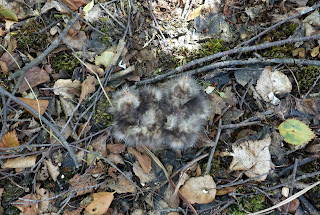Over the summer Tim was working on ringing Nightjars on the peat bogs between Doncaster and Goole. I managed to negotiate a day off work and had the pleasure of going out with him. During the day we worked Hatfield Moor tracking individual adult Nightjars with radio transmitters in the hope of finding some nests. We found three nests; the first had some fledged chicks we Tim stumbled across by chance, the second had two mid-sized chicks one of which I was able to ring, and the third nest had two chicks that had just hatched. At the final nest we also caught the female, on whom we put a data logger.
In the evening we went out onto Thorne Moors where we set up nets to try and catch adult birds to retrieve data tags. We caught three adult birds, a female and two males. All the birds were already ringed , but it was still fun to hold the birds whilst the tags were put on them. The mosquitoes were an absolute nightmare but it was worth the pain.
Thorne and Hatfield are both excellent sites. Whilst out on the reserves we had excellent views of Turtle Dove and Hobby, and we heard the Cranes calling distantly, although we did not see them. We also had plenty of dragonflies including hundreds of Black Darters, plus Southern, Brown and Common Hawker, the latter (My favourite dragonflies) are the first I have seen for some years.
-First Nightjar chicks
-Younger Nightjar chicks
-Adult female Nightjar
Species List:
Thorne and Hatfield Moors: Greylag Goose, Mallard, Teal, Tufted Duck, Grey Heron, Little Egret, Hobby, Kestrel, Little Owl, Pheasant, Grey Partridge, Lapwing, Redshank, Turtle Dove, Stock Dove, Woodpigeon, Green Woodpecker, European Nightjar, Jackdaw, Carrion Crow, Rook, Meadow Pipit, Linnet, Greenfinch, House Sparrow, Reed Bunting, Southern Hawker, Brown Hawker, Common Hawker, Emperor Dragonfly, Black-tailed Skimmer, Common Darter, Black Darter, Emerald Damselfly, Common Blue Damselfly, Large White, Ringlet, Meadow Brown, Common Blue, Peacock, Small Tortoiseshell, Red Admiral,






No comments:
Post a Comment